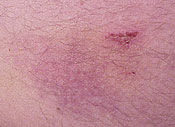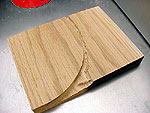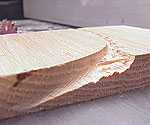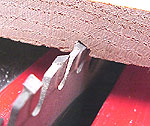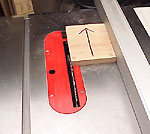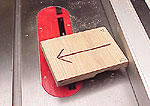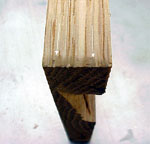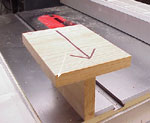This is a Veteran Owned site
 |
||
Kickback!This time it wasn't someone elseText, photos and mistakes by Tom Hintz The MistakesThe cause of this kickback incident (my first on a table saw) is the painfully obvious result of two bad decisions on my part. The machine, my Jet contractors saw, did nothing wrong. My first, and most grievous error, was not having the splitter installed. I know better, and have no good excuse. Like far too many woodworkers, I left the factory-supplied splitter off because it is inconvenient in some instances and impossible to use for other operations such as cutting dados. Now, a fresh softball-sized tender spot on my gut is causing me to reconsider how that level of inconvenience compares to what I am feeling 24 hours later. Besides feeling dumb, kickback hurts. It occurs to me that installing the splitter takes time, but causes no pain. My second error was not using my band saw to make this cut. I was simply reducing the size of an already small piece of wood that I knew could be done with complete safety on the band saw. Exactly why I decided to make the cut on the table saw escapes me. Looking back, I can see no legitimate justification.
What HappenedI had to remove 5/8" from the side of a 5 ½" by 6 3/8" piece of ¾"-thick clear white oak. I had the blade height set as I always do, with the gullets almost fully exposed above the wood. I was guiding the piece through the saw with my favorite push device, the Stots Saw-Aid, which did not contribute to this incident in any way. In fact, the Saw Aid is probably responsible for my intact right hand. I had actually completed the cut itself, the cut off piece had separated and was lying motionless next to the blade. As the main portion of the wood began exiting the blade, I had the sensation that I was pushing down on the rear of the piece rather than flat as I normally do. With even pressure across the work piece I can use the forward portion of the Saw-Aide to keep the leading end of the workpiece against the fence, and out of the blade. I have no explanation for why I felt I was applying pressure to only the rear or the workpiece. Subsequent events appear to substantiate that feeling, though. At that point, I heard the blade begin engaging the wood, followed almost instantly by a "bang" and the near simultaneous feeling of the wood impacting me. There was no time to change how I was applying pressure to the workpiece. Hearing the blade engaging the wood and the start of the kickback itself were almost simultaneous. The main portion of the wood struck me in the stomach, approximately 4 inches above the table surface and slightly off center to the right. After hitting me, that piece of wood flew across the shop, coming to rest a little over 8 feet to the left and about 3 feet behind me. At the same instant, I felt something hit my left hand and initially thought it was part of the main piece of wood, thinking part of it had broken off. Apparently, the main piece of wood struck the cut off as it rotated through the blade.
The InjuryI feel fortunate that the injury I received was not worse. At the time of the kickout I was wearing a heavy knit sweatshirt that has a hand-warmer style pocket across the front that effectively doubled the padding the material afforded at the point of impact. That double layer of thick knit material may have protected me to some extent, limiting the injury to a small cut and a not-so-small bruise. Had I been wearing my customary cotton t-shirt at the time, things could have been much worse. The fingers struck by the cutoff piece have a small outline of the piece and a little bruising, but are otherwise undamaged. Again, lucky to some extent as it appears both pieces of wood were moving quite fast.
The Mechanics of the KickoutWhile many think a kickout is simply the result of the blade catching on and throwing the wood back at you, that apparently is seldom the case. I had heard from reputable people in the past that the wood actually rotates against the fence before being thrown out. When I looked at the main portion of the wood, that theory was graphically borne out. The cut in the face of the piece that was against the saw table clearly shows rotation. Interestingly, the radius of the arc equals the width of the piece at its beginning and tightens slightly as it reached the end of the wood. The arc the blade took across the wood shows that it indeed rotated against the fence on the lower right corner (Corner A in the photos) of the wood, viewed from the operator position. What surprised me was the damage to the lower left corner of the wood that shows the piece had rotated completely, bashing the lower left corner (B in the photos) into the fence. In that position, the blade was at the final edge of the wood. I suspect the "bang" I heard was the lower left corner of the wood impacting the fence, driven by the blade catching the edge of the wood at the same instant. I believe it is at this point that the wood actually was launched. Inspecting the arc-shaped cut in the wood suggests the wood both lifted and accelerated as it passed over the blade. The beginning of the cut is smooth on the inside edge and nearly the full depth of the wood. From there, the cut grows shallower as the wood turned and came out from under the push stick. I also noticed that as the cut grows shallower you can see impressions of individual teeth, suggesting that the wood was beginning to approximate the speed of the blade. I found it interesting that the end of the cut is almost exactly as deep as the carbide tooth is tall, and the shape of the cut matches the profile of one of the beveled teeth, (Alternate Tooth Bevel combination blade) the slant running towards the fence. The damage to the corner of the wood that impacted the fence last suggests the wood was relatively flat in relation to the table surface at the point it was launched. The shape of the bruise also indicates the wood remained relatively flat while in flight. To determine the approximate path the wood took from the saw to me, I positioned myself as I normally stand and moved the Saw-Aid past the blade. I blocked the wood up to match the level of the bruise and found that was about 4 inches above the table. With the final edge of the arc cut on the edge of the blade facing me and corner B against the fence, the angle to the bruise is about 40 degrees. I feel this supports the theory of the "B" corner of the wood being the actual pivot point at the instant the wood was thrown out.
ConclusionsThe first order of business is for me to get smarter when using my table saw. The fact this was the first time I had been whacked by a kickback is irrelevant. I have to make sure it is the last time it happens. While I plan to seriously investigate the Biesemeyer and similar aftermarket splitters, I will take a long hard look at the factory splitter to see if there is a way to make it more user-friendly in the interim. What is most frustrating is the realization that I did exactly what my Safety Survey story of last year so clearly showed. I grew complacent in the use of my power equipment, something that remains the number one reason woodworkers get hurt. I was fully aware of that, but did it anyway. I have nobody to blame but myself. Do you have a comment about this page? - Email Me!
|
All written, photographic and drawn materials are property of and copyright by NewWoodworker.com LLC 2000-2019. Materials may not be used in any way without the written permission of the owner.

